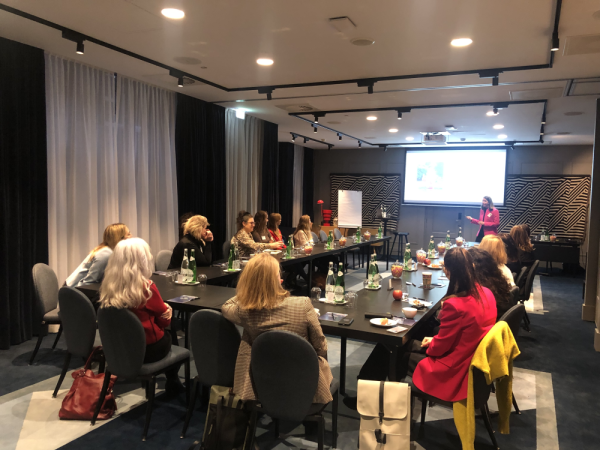Much ink has been spilled about the cultural and commercial phenomena of Barbie, Beyoncé, and Taylor Swift, literally economies of their own in 2023. Although not quite at that level (yet), there is a powerhouse group of women behind some of the most sophisticated and transformative marketing technology operations across the globe who recently gathered in Amsterdam, and I was extremely fortunate to be part of the occasion.

I took enough notes for multiple blog posts so watch this space, but here are my top five takeaways from BlueConic’s first-ever Women in Technology Leadership Forum.
You’re worth it. Why try to say it better than Josefine Boqvist, CEO & Co-Founder of Deerdata did? “You’re worth it. You’re doing a good job. We’re all doing a good job…There is a lot of change that needs to happen, and we need to help each other to break that.” While marketing as an industry is dominated by women, marketing technology as a discipline suffers from many of the same challenges that other tech does. Taking the time to be among peers from both the brand and agency sides of our industry to learn and share is a privilege, and we all embraced that gift. I felt similarly after our most recent Customer Advisory Board. It’s so exceptional to be around brilliant, innovative people from a variety of industries to compare notes and experiences. As we reflect on 2023 and set goals for ourselves in 2024 and beyond, we must set aside time to invest in ourselves and each other. We’re worth it.
Overall success is delivered in fragments. One of my favorite points that Erica Campbell, Global Consumer Data & Analytics Director at Electrolux, made in our fireside chat was one that I believe is a hallmark of the most successful BlueConic customers across the board: they start small and “fragment delivery to users faster” as Erica put it, so as to get wins on the board and build a system of success. Alexis Hoopes, Mattel’s VP of eCommerce, said something very similar when we spoke in August at eTail Connect West about the importance of building a foundation while getting quick, consistent wins. Martech initiatives generally, and customer data platform (CDP) implementations specifically, are about creating institutional discipline. These initiatives take time and are as much about people and process (more on that in a second) as they are about the technology, so you’ve got to set your team up for the long game. Josefine said it beautifully: “You get the smaller wins and you avoid the bigger mistakes.”
The technology is just the beginning. Imagine explaining flying in an airplane to someone who has only ever ridden a bicycle. Sure, both are types of transportation, but that’s where the similarities stop. It's not just a step up; it's a whole new way of moving forward. In a similar vein, “implementing a CDP” is really the wrong way to frame making a new investment in your technology stack. Done well, you’re introducing a new way of working whereby the business can act more quickly, at greater scale, and with higher quality data. A customer data platform transforms how we plan, implement, and evaluate marketing strategies, making it an exciting leap forward from traditional methods, but it’s also potentially daunting and challenging for people in your organization to fully grasp.That’s why it’s critical for leaders implementing new technology, or leading any transformation initiative for that matter, to be on top of helping their teams navigate change, whether with training to up-skill as the marketing landscape evolves or managing the emotions that accompany any change, even for the better.
Balance standardization with customization. The topic of balancing standardization with customization resonated with nearly everyone in the room, and I find it to be one that almost every global “multi” organization (our speciality) grapples with. How do we balance the requests to tailor aspects of the CDP for different brands or markets? Erica had some wisdom from Electrolux’s CMO, who advised her and her team to be “As common as possible, as different as necessary.” I like it as a much better version of my own, “Every customer is a snowflake but all snowflakes are made of snow.” However you want to phrase it, the need for central CDPs to manage competing priorities, scope, and urgency is a seemingly universal challenge (if you’ve nailed this, reach out because I want to hear about your magic) and the discussion around the room offered the following advice:
Get all requirements up front with details about the expected business value, the impact on consumers (and how many), and available budget to support the custom work.
Maintain a list of the near-term priorities adjacent to the bigger backlog so that internal stakeholders can see both what is happening and what isn’t (or at least not yet).
Be crystal clear about the tradeoffs, document them accordingly, and refer back to that list regularly - especially with leadership - to make sure priorities stay on track.
Leadership is a journey of actively seeking growth. Everyone who attended the Forum shared a genuine curiosity about our industry and a desire to grow in their careers, whether that meant taking on new roles, acquiring new skills, or applying their knowledge to new geographies. Unsurprisingly, this ambition is part of why the discussion at the event was so rich. Attendees were not only keen to delve into a range of topics—from navigating imposter syndrome to the practicalities of system implementation—but were also genuinely interested in forging connections with their peers. We had a range of career stages present, and it was abundantly clear that those who bring energy to learning are the ones seeing the most success in their careers.
This event was such a catalyst to finish the year strong and hit 2024 running! Thank you to all attendees for your insights and your enthusiasm. Be sure to keep an eye out for more events like the Women in Technology Leadership Forum in the future.







